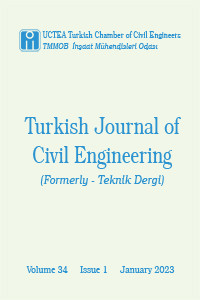Large Scale Direct Shear Box Tests on Gravels
Murat River gravel, direct shear box test, angle of shearing resistance, dilation angle, void ratio
Large Scale Direct Shear Box Tests on Gravels
Murat River gravel, direct shear box test, angle of shearing resistance, dilation 28 angle, void ratio,
___
- Asadzadeh, M., Soroush, A., Direct Shear Testing on a Rockfill Material. Arabian Journal for Science and Engineering, Vol. 34, No. 2B, 379-396, 2009.
- ASTM D3080 / D3080M – 11: Standard Test Method for Direct Shear Test of Soils Under Consolidated Drained Conditions
- ASTM D854: Standard Test Methods for Specific Gravity of Soil Solids by Water Pycnometer
- ASTM D6913 / D6913M-17, Standard Test Methods for Particle-Size Distribution (Gradation) of Soils Using Sieve Analysis, ASTM International, West Conshohocken, PA, 2017, www.astm.org
- Bolton, M. D., The strength and dilatancy of sands. Geotechnique, Vol. 36, No. 1, 65-78, 1986.
- Frossard, E., Hu, W., Dano, C., Hicher, P. Y., Rockfill shear strength evaluation: a rational method based on size effects. Géotechnique, Thomas Telford, 62 (5), pp.415-427, 2012.
- Li, X. Z, Li, J. L., Deng, H. F., In-Situ Direct Shear Test Research of Rock and Soil of Typical Bank Slope in Three Gorges Reservoir Area. Electronic Journal of Geotechnical Engineering, Vol. 19, Bundle K, 2523-2534, 2014.
- Liu, S. H., Application of in situ direct shear device to shear strength measurement of rockfill materials. Water Science and Engineering, 2 (3): 48-57, 2009.
- Liu, S. H., Xiao, G. Y., Yang, J. Z., and Wu, G. Y, New in-situ direct shear tests on rockfill materials at Yixing Pumped Storage Power Station Project. Chinese Journal of Geotechnical Engineering, 26(6), 772-776, 2004, (in Chinese).
- Matsuoka, H., Liu, S. H., Sun, D., and Nishikata, U., Development of a new in-situ direct shear test. Geotechnical Testing Journal, 24(1), 92-102, 2001. [doi:10.1520/GTJ11285J]
- NAVFAC, Soil Mechanics Design Manual 7.01. Naval Facilities Engineering Command, 1986.
- Powers, M.C., A new roundness scale for sedimentary particles. Journal of Sedimentary Petrology, 23:117-119, 1953.
- Simoni, A., Houlsby, G.T., The Direct Shear Strength and Dilatancy of Sand-gravel Mixtures. Geological and Geotechnical Engineering, Vol. 24, pp. 523-549, 2006.
- Vasistha, Y., Gupta, A. K., Kanwar, V., Prediction of Shear Strength Parameters of Two Rockfill Materials. Electronic Journal of Geotechnical Engineering, Vol. 17, Bundle W, 3221 – 3232, 2012.
- Vermeer, P. A., de Borst, R., Non-associated plasticity for soils, concrete and rock. Heron, Delft University of Technology, Vol. 29, No.3 , 1984.
- Wadell, H., Volume, shape and roundness of rock particles. Journal of Geology, 40:443-451, 1932.
- Wang, J. J., Yang, Y., Chai, H.J., Strength of a Roller Compacted Rockfill Sandstone from In-Situ Direct Shear Test. Soil Mechanics and Foundation Engineering, Vol. 53, No.1, March 2016.
- Xiao, Y., Liu, H., Chen, Y., Jiang, J., Strength and Deformation of Rockfill Material Based on Large-Scale Triaxial Compression Tests. I: Influences of Density and Pressure. ASCE Journal of Geotechnical and Geoenvironmental Engineering, Vol. 140, No:12, December 2014.
- Xiao, Y., Liu, H., Zhang, W., Liu, H., Yin, F., Wang, Y., Testing and modeling of rockfill materials: A review. Journal of Rock Mechanics and Geotechnical Engineering, Vol. 8., 415-422, 2016.
- ISSN: 2822-6836
- Yayın Aralığı: 6
- Başlangıç: 1990
- Yayıncı: TMMOB İnşaat Mühendisleri Odası
Teaching-Learning Based Optimization of Nonlinear Isolation Systems under Far Fault Earthquakes
Seda ÖNCÜ-DAVAS, Rasim TEMÜR, Cenk ALHAN
Large Scale Direct Shear Box Tests on Gravels
Ali Anıl YUNATCI, Kemal Onder CETIN
A New Minimum Delay Model for Multi-Lane Traffic Circles
Serhan TANYEL, Süheyla Pelin ÇALIŞKANELLİ, Mustafa ÖZUYSAL
Khaled ALRAMLAWİ, Okan FISTIKOĞLU
Analysis of a Prefabricated Vertical Drain (PVD) Soil Improvement Project
Ahmet Can MERT, Akın ÖNALP, Ersin AREL
Nihat KABAY, Ahmet Beşer KIZILKANAT, Busra AKTURK, Yusuf KAHRAMAN
Fundamental Frequencies of Elliptical Plates using Static Deflections
The Strain Sensitivity of Coal Reinforced Smart Concrete by Piezoresistive Effect
Özkan KOLATAR, Egemen TEOMETE, Serap KAHRAMAN
Sediment Incipient Motion in Sewer with a Bed Deposit
Wan Hanna Melini WAN MOHTAR, Charles BONG HIN JOO, Aminuddin AB GHANI, Mir Jafar Sadegh SAFARI, Aizat Mohd TAIB, Haitham AFAN, Ahmed EL-SHAFIE
Application of the Dynamic Compaction Method for Ground Improvement of Collapsible Loess in Qinhai
